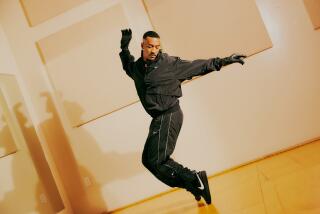Choreographer’s Dancers Find the ‘Uncomfort Zone’
SAN DIEGO — Mehmet Memo Sander, the choreographer who founded the Mehmet Memo Sander Dance Company in 1990, says he is unconcerned with lyricism or dance’s traditional connection to music. He says he is after pure, unconcealed movement. Sander’s Los Angeles-based seven-member company opens Sushi Performance and Visual Art Gallery’s new “Danse Fraiche” contemporary dance series Thursday through Saturday.
“People say of what I’m doing, ‘oh, it’s brutal,’ but it’s not necessarily a masculine or ‘man’ movement,” said Sander, 25, in a recent telephone interview, his Turkish accent evident. Sander moved to the United States in 1987 to continue his dance studies, after dancing professionally in Istanbul and studying dance in London.
“We’re doing ‘Off Our Backs’ (in San Diego), which is a piece for four women, and the reason I choreographed it on women is that there are still some taboos in the dance world as to who plays which role in terms of partnering and strength. This piece proves that anyone, by working very hard, is capable of doing anything physically.
“Each time you force yourself to do something heavier and stronger,” Sander explained, “you feel uncomfortable, but if you go one more step, you get stronger. As human beings we can’t fly, but if we would try for about 2,000 years, without giving up, maybe we wouldn’t be flying, but we’d start to develop wings. The body develops and the mind takes over.
“This is the direction I am going. I want to be in my ‘uncomfort zone’ and so do my dancers. We never know our limit until we push it to its maximum and I don’t know where that maximum is.”
Merce Cunningham’s ideas about movement in space and time have influenced Sander.
“I think dance is suffering from a lack of thinking about what movement is,” he said.
The company will perform five dances, among them “Board Stiff,” as well as a high-velocity solo danced by Sander in the nude, called “18 Leviticus.” Originally, the work was titled “18,” because Sander had devised 18 ways to physically define the geometrical spaces created by a crucifix shape, within 2 minutes. But when he performed the piece in Texas recently, someone showed him the Old Testament.
The coincidence was striking, so he added “Leviticus” to the title.
Sander’s work is not solely or even directly about his personal world, his homosexuality or his non-American heritage. He is more interested, he said, in making new movements and raising questions about the old ones of dance.
More to Read
The biggest entertainment stories
Get our big stories about Hollywood, film, television, music, arts, culture and more right in your inbox as soon as they publish.
You may occasionally receive promotional content from the Los Angeles Times.










